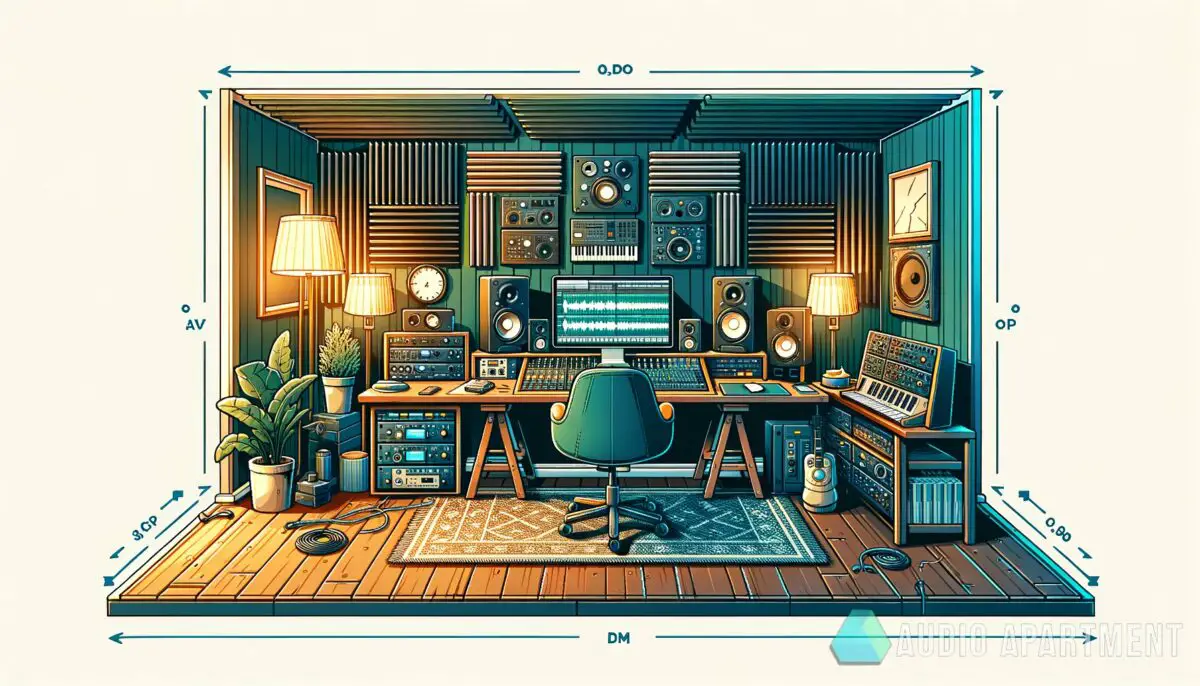In the bustling streets of your local music gear shop, the debate on the best audio interfaces for home studios is as heated as discussions about vintage versus modern studio monitors. It’s a choice that can set the stage for your musical journey.
Here, you’ll learn how to pick the perfect audio interface to kickstart your recording adventure.
If you are a visual learner, check out this video titled ‘Everything You Need To Start Recording Your Music’
Key takeaways
- Choosing the right audio interface is crucial for quality recordings.
- Invest in good gear, but also maximize what you currently have.
- Update your DAW and plugins regularly for the best features.
- Experiment with microphone placements for the perfect sound.
Which audio interfaces will elevate your home recordings?
Diving into the realm of home music production can feel like navigating a maze. The heart of your setup?

An audio interface. It’s not just about getting any gadget; it’s finding the one that syncs with your vibe, budget, and needs.
This guide zeroes in on the top 5 audio interfaces that promise to lift your home studio from the ground up, delivering stellar recordings that do your music justice.
1. Focusrite Scarlett 2i2 (3rd Gen)
This compact powerhouse is a first-timer’s dream, blending top-notch quality with an affordable price tag. The Scarlett 2i2 interfaces effortlessly with your DAW, offering two inputs that can handle anything from vocals to electric guitars.
Its low latency ensures a smooth recording session, perfect for laying down those spontaneous midnight tracks.
Why snag this one? Apart from its intuitive design, the Scarlett 2i2 provides crystal clear recordings.
You’ll appreciate its solid build and the bundled software—getting you in the mix right out of the box. Pair it with some of the best studio headphones for a pristine listening experience during long mixing sessions.
2. Universal Audio Apollo Twin MkII
The Apollo Twin MkII rolls in as a premium pick, offering unmatched audio quality and the unique inclusion of UAD-2 plugins. This interface transforms your home studio, giving you access to analog emulations that have colored countless legendary records.

Choosing the Apollo Twin MkII means stepping up your game. Its onboard processing powers plugins without taxing your computer, enabling a richer, more detailed production process.
Dive into advanced recording techniques, leveraging the potential of top-tier MIDI controllers to further enrich your sound.
3. Presonus AudioBox USB 96
On a budget but still hungry for quality? The Presonus AudioBox USB 96 is your golden ticket.
Don’t let its modest price fool you; this interface packs a punch with 24-bit resolution, ensuring detailed, vibrant recordings. Its compatibility across various operating systems and DAWs makes it an accessible choice for every producer.
What sets it apart is its durability and the ease it brings to mobile recording. Whether capturing the ambiance of the outdoors or the energy of live instruments, adding it to your toolkit opens up new creative horizons.
Connect it with high-quality microphones to nail those high-definition takes.

4. Steinberg UR22C
If you’re seeking balance between affordability and professional features, look no further than the Steinberg UR22C. Equipped with studio-grade converters and two D-PRE mic preamps, it stands as a reliable bridge between your musical ideas and polished tracks.
Its compatibility with a wide range of sampling rates perfects your recordings with lucid detail.
Ideal for producers dabbling in electronic genres, the UR22C’s MIDI I/O connects seamlessly with synths and drum machines, expanding your production landscape. Consider enhancing your setup with understanding audio compression for tighter, punchier mixes.
5. Audient iD4 MKII
“Creating amazing recordings in your home studio is not just a matter of having the right gear. It’s about understanding the intricacies of sound and learning how to manipulate it to your advantage.Regularly update your DAW and plugins for access to the latest features and fixes.”
Rounding off our list is the Audient iD4 MKII, a marvel in its right, known for delivering audio quality rivaling interfaces twice its price. With a single Audient console mic preamp and a JFET instrument input, it captures the essence of your music, ensuring warmth and accuracy.
The Audient iD4 MKII is a testament to the idea that pro-level features can come in small, budget-friendly packages. When used in conjunction with techniques to add spatial depth with reverb, this interface allows indie artists and beginners to craft recordings that stand toe-to-toe with the pros.
AKAI Professional MPK Mini MK3

AKAI Professional MPK Mini MK3
More creating amazing recordings tips
Creating amazing recordings in your home studio is not just a matter of having the right gear. It’s about understanding the intricacies of sound and learning how to manipulate it to your advantage.
Here are some more steps you can take to enhance the quality of your recordings and truly bring your music to life:
- Regularly update your DAW and plugins for access to the latest features and fixes
- Experiment with microphone placements to find the perfect sound for each instrument
- Utilize room treatment options to minimize unwanted echo and reverb
- Develop your ear for mixing and mastering through practice and critical listening
- Collaborate with other musicians to learn new techniques and perspectives
- Keep your recording environment organized to streamline your creative process
Dos and don’ts of creating amazing recordings:
| Do | Don’t |
|---|---|
| Do invest in quality cables and connectors. | Don’t overlook the importance of room acoustics. |
| Do take breaks to maintain a fresh ear. | Don’t rush the mixing and mastering process. |
| Do use reference tracks for mixing. | Don’t record at excessive volume levels. |
| Do back up your projects regularly. | Don’t neglect to tune instruments before recording. |
Practical tips to elevate your home studio recording sessions.
Advantages and disadvantages of creating amazing recordings
In the age of digital music production, the ability to create amazing recordings from the comfort of your own home has become more accessible than ever. This democratization of music production has its own set of advantages and disadvantages, shaping the way artists produce and share their music.
Advantages
- Cost-effective compared to professional studio recordings
- Greater control over the creative and production process
- Ability to experiment and record at any time without time constraints
- Opportunities to learn and become self-sufficient in various aspects of music production
Disadvantages
- Lack of access to high-end equipment and acoustically treated spaces
- Potential for lower quality recordings if not done correctly
- The learning curve can be steep and time-consuming
- Isolation from the collaborative environment found in professional studios
In my opinion, as someone who’s still getting their feet wet in the world of music production, the journey can be as thrilling as it is daunting. Choosing the right audio interface feels like picking a companion for an adventure—crucial and somewhat personal.
While the array of options can overwhelm, narrow down your choices by focusing on what matters most to your music. Remember, an audio interface can hugely influence the sound quality of your recordings, making it a cornerstone of your home studio.
It’s also important to consider the broader ecosystem of your studio setup. An audio interface doesn’t work in isolation but in concert with your microphones, monitors, and even the acoustic treatment of your room.
Investing in the best equipment you can afford is advisable, but learning to make the most out of what you have is equally essential. For insights on optimizing your home studio, check out key aspects of vocal production in home studios.
Frequently asked questions (FAQ)
Can I use multiple audio interfaces at the same time?
Yes, it’s possible to use multiple audio interfaces simultaneously, but it requires a compatible computer and DAW setup, as well as possibly more software to manage audio synchronization. This setup can expand your input/output capabilities and flexibility for larger recording sessions.
How important are the preamps in an audio interface?
Preamps are critical in an audio interface as they amplify microphone signals to line-level. The quality of the preamp can significantly influence the clarity, warmth, and overall quality of the recorded sound.
High-quality preamps can make a noticeable difference in your recordings, capturing more detailed and full-bodied audio.
Does a higher sample rate mean better quality recordings?
While a higher sample rate can capture more detail and potentially improve sound quality, it also demands more from your computer’s processing power and storage. Most professional recordings are made at 44.1kHz or 48kHz.
Going higher can offer benefits for certain types of recordings, but it’s not always necessary for quality productions.
Final thoughts
As we wrap up, it’s clear that embarking on the journey of home music production is an exciting venture filled with learning curves and rewarding milestones. Choosing the right audio interface is foundational to creating amazing recordings that capture the essence of your artistry.
Remember, it’s not solely about the specs or the price; it’s about finding the interface that resonates with your workflow and enhances your creative process. So, take your time, do your research, and soon, you’ll be on your way to producing tracks that you’re proud to call your own.
What do you think about the list of audio interfaces we discussed? Did I cover everything you wanted to know? Let me know in the comments section below I read and reply to every comment. If you found this article helpful, share it with a friend, and check out my full blog for more tips and tricks on creating amazing recordings.
Thanks for reading and here’s to making music that moves and inspires!















